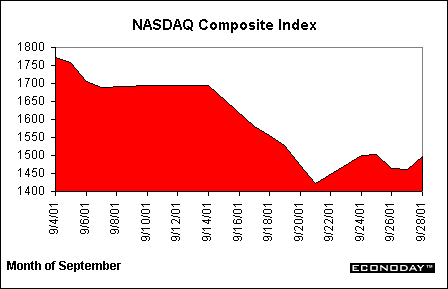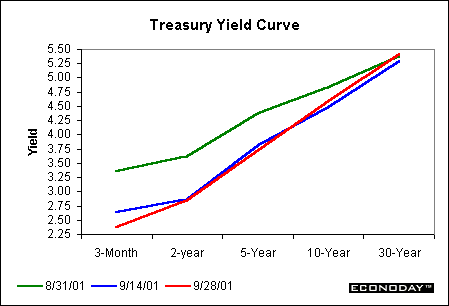Equities began the month of September at a similar pace to that at the end of August, as volumes started increasing at the same time profit warnings continued to hit the markets. Markets, and the rest of the world, then received the shock of a lifetime, as terrorists rammed airplanes into the World Trade Center on September 11. Equity markets were shut down for the remainder of the week, set to re-open on the 17th. Before the market re-opened, the FOMC surprised the trading community by lowering interest rates by 50 basis points. Despite the assistance from the FOMC, the Dow Jones Industrial Average fell off drastically as trading began joined by every other major index. The Dow sell-off sent the index to low levels not seen in four years, down to around 8,900 points. The NASDAQ composite index also had begun the month with a low level and a mostly negative outlook, and the terrorist attacks sent the NASDAQ down to around the level before the technology run-up two years ago. Earnings warnings from technology companies also hit the market after the attack, and kept market players from ever gaining any sense of optimism or sustaining any market rallies. Investors also had to deal with mixed economic reports, and more than a handful of economists is predicting a mild recession or worse. No investors are looking forward to profits for at least six months and possibly longer.

Sectors that had been performing well in the past few months continued their recent downturn, as technologies and retailers lost any recent gains. Health care stocks and the financial sector dominated the positive performers, while entertainment, leisure and transportation stocks dropped like stones in the wake of the attacks. Energy stocks also increased from their August levels, finally starting to show some life after showing some recent negative trends. Specifically, airline stocks dominated the moves down across the equity market.

There were a few major daily moves in the month worth noting, as on September 17th, markets reopened and fell to drastic lows. The Fed's move on the 17th appeared to do nothing to slow the bleeding as the week from the 17th to the 21st saw the worst point-loss performance in history for the Dow, but experts believe it helped alleviate some of the downward pressure. September 24th turned out to be a particularly positive day in the month, as some investors took advantage of the massive declines to find good bargains. However, negative days far outweighed positive days across equity indices for the month of September. The Dow finished down 11.1 percent, while the NASDAQ finished down 17.3 percent. The S&P 500 moved similarly, finishing down another 8.3 percent for September. The Russell 2000 declined 13.7 percent on the month, while the market-encompassing Wilshire 5000 index decreased 9.1 percent in September.
| Date |
DJIA |
S&P 500 |
NASDAQ |
Russell 2000 |
Wilshire 5000 |
| 12/29/00 |
10788.75 |
1320.50 |
2471.37 |
483.54 |
12175.88 |
| 01/31/01 |
10877.36 |
1366.01 |
2772.89 |
508.34 |
12631.57 |
| 02/28/01 |
10493.33 |
1239.54 |
2151.51 |
474.11 |
11420.21 |
| 03/30/01 |
9875.60 |
1159.41 |
1839.63 |
450.12 |
10635.95 |
| 04/27/01 |
10734.64 |
1250.39 |
2116.47 |
485.71 |
11512.19 |
| 05/31/01 |
10990.41 |
1260.81 |
2149.44 |
501.52 |
11672.56 |
| 06/29/01 |
10503.75 |
1299.58 |
2169.31 |
510.30 |
11413.63 |
| 07/31/01 |
10522.8 |
1213.3 |
2027.1 |
484.5 |
11204.9 |
| 08/31/01 |
9949.8 |
1133.6 |
1805.4 |
468.6 |
10515.1 |
| 09/28/01 |
8847.1 |
1039.9 |
1498.6 |
404.2 |
9553.6 |
|
|
|
|
|
|
Treasury Market- Flying to Quality
The market for Treasuries gained only slightly at the beginning of September before the attacks. Economic reports showed continuing negative conditions during the month. Then the attack occurred, and even more investors just could not get enough of Treasury securities. Yields again dove down across the yield curve. While prices of Treasury securities did show some negative movement on days that stocks performed well amidst bargain-buying opportunities, these securities maintained most of their gains through to the end of the month. The lone poor performer became the 30-year bond, which worried investors, as there was some concern over the amount of supply. Without the terrorist attacks, however there are mixed signs in the economy, as the six-month outlook begins to brighten. Other positive news for Treasuries includes the fact the FOMC remains ready to continue lowering interest rates.

As the chart shows, yields save for the 30-year bond moved down across the board as the trend in the fixed-income market continues to be positive. (Remember that a weak economy translates into favorable trends for the fixed income market.) Treasury securities yields posted drastic declines for the most part in September. At the longer end, the 30-year bond increased 5 basis points on the month, and the 10-year note dropped 25 basis points. At the shorter end of the curve, the 5-year note lost 58 basis points, the 2-year note fell 67 basis points and the 3-month bill declined by 99 basis points for the month of September.
Damir Fonovich, Economist, Econoday
|
